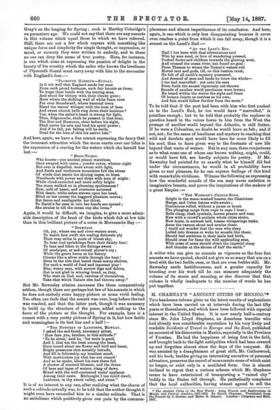M. CHARNAY'S "ANCIENT CITIES OF MEXICO." 4 Tins handsome volume gives
us the latest results of explorations which have been carried on at intervals during the last fifty years or thereabouts, and which have been followed with especial interest in the United States. It is now nearly half-a-century since Mr. John Lloyd Stephens, an American traveller who had already won considerable reputation by his very lively and readable Incidents of Travel in Europe and the East, published an account of his discoveries in Mexico, especially in the Province of Yucatan. He had the happiness of being first in the field, and brought back to the light antiquities which had been covered up and forgotten almost since the days of the conquest. He was assisted by a draughtsman of great skill, Mr. Catherwood, and his book, besides giving an interesting narrative of personal adventure, preserves the record of monuments some of which exist no longer, or exist only in a mutilated form. One is almost inclined to regret that a curious scheme which Mr. Stephens seems to have entertained of transporting a "ruined city" bodily to the States fell through. He pathetically complains that the local authorities, having almost agreed to sell the • The Ancient Cities of the Nets World: being Travel* and Explorations in Mexico and Central America. 1x57.1883. By Desird Chernay. Translated from the French by J. Genius and Helen 8. Conant. London Chapman and Hall. 1837.
remains of Quirigna for a few thousand dollars, were afterwards induced by the French Consul to put a prohibitory price upon them, and that the hope of supplying his native country with its great need, a set of genuine native antiquities, had to be given up. France and the States seem to have worked more happily together in the explorations conducted by M. Charnay. He dedicates his work to an American millionaire, Mr. Peter Lorillard, who had formed an independent plan for an expedition with the same object, and of whose generous aid he makes a handsome acknowledgment.
It is to be feared that we mast give up as a romancer the cure who told Mr. Stephens that he had seen with his own eyes, from the heights of a neighbouring sierra, the flashing roofs and pinnacles of a city in which the mysterious race which had built Copan and Palenque still retained its ancient civilisation. It in a romance which has been fondly cherished, and, of course, exploited. Our readers will remember the exhibition of two curious specimens of humanity who were said to be survivors of the race whose characteristic features—in which the exaggerated curve of the nose is especially noticeable—may be seen in the sculptures of the Yucatan ruins. The result of M. Charnay's researches tends to substitute for these imaginations a more solid historical truth. He is convinced—and gives very good reasons for his conviction—that the ancient American civilisa- tions were in fact one, and that this can scarcely be called ancient, dating as it does, according to the earliest computa- tion, many centuries after the Christian era. To this civilisa- tion he gives the name of " Toltec," and he traces the movements of the race from their first settlement in the Mexican highlands, a progress agreeing with the development of their art as it is still to be seen in the ruins of the great cities which they built. If this thesis is to be considered established, there yet remains a question which is scarcely likely to be settled. Where did the Toltecs come from P Speculations on this point have been very various, and, it is almost needless to say, very wild. So tempting an opportunity of locating the Lost Tribes of Israel of course has not been overlooked, and there is certainly something Hebraic about the Toltec nose. The architectural use of the pyramid has been interpreted as showing an Egyptian origin, though the pyramid is the obvious resource of builders who wish to secure a strong foundation. M. Charnay is inclined to trace them to the extreme East of Asia, finding something Japanese in their architecture, something Chinese in their decorations, and something Malayan in their social order, a very curious and suggestive combination. But he does not spend much time or space on these speculations. " The question of first origins " seems to him "an idle pursuit," and he devotes himself with an industry which is deserving of all praise, to an elaborate examination of the remains which this curious people have left, to the inferences as to their life and civilisation which may be gathered from them, supplemented as they are by the scanty records which we owe to the Spanish invaders. The result of this examination is before us in this volume, a work worthy in every way of the labours which it describes. M. Charnay writes an admirable narrative, to which the translation, the ease and vigour of which cannot be praised too highly, does full justice. The illustrations are numerous and good ; none of them, perhaps, quite equal to the more elaborate of those which Mr. Catherwood executed for Mr. Stephens, but fully adequate to their purpose. As books that deal solely with exploration are apt to be dull, we should add that the personal element in the narrative of M. Charnay'e investigation is neither wanting nor made too prominent, and that the reader will be entertained and interested by much detailed information about the life of to-day in these regions.



































 Previous page
Previous page